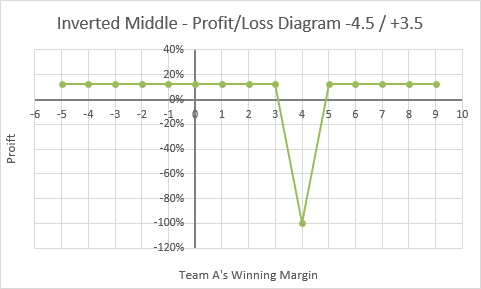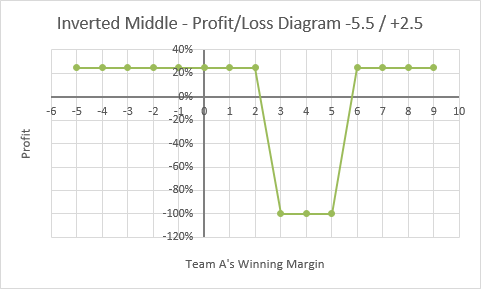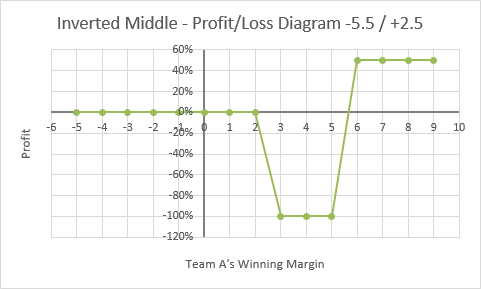You are here: Home >> Beginner’s Guide >> Betting Strategies >> Inverted Middles / Polish Middles
The following is an overview of the betting strategy called Polish middles, also called inverted middles.
In contrast to a standard middle, which profits if the total or line falls inside a certain range, an inverted middle, also called a Polish middle, profits if the total or line falls outside a specific range.
The betting strategy consists of two wagers at different lines or totals such that it profits if the line or total falls outside the range in-between them.
While standard middles have limited downside risk because you’re guaranteed that at least one line wager will win, inverted middles carry 100% downside risk because there is the possibility that both wagers will lose. At the same time, however, standard middles only profit if a very specific outcome occurs, while inverted middles only lose money if a specific outcome eventuates. Learn more about standard middles.
An opportunity for an inverted / Polish middle may arise either because bookmakers have simultaneously published different lines or because the line has shifted since your first wager was placed.
Line Betting Examples
An opportunity for an inverted / Polish middle arises if two different lines are published and the sum of the reciprocal of the decimal odds is less than 1.00.
Suppose you’ve observed following two line selections:
Bet 1: Team A -4.5 at 2.25 odds with bookmaker X
Bet 2: Team B +3.5 at 2.25 odds with bookmaker Y
An opportunity for an inverted/Polish middle exists because 1/2.25 + 1/2.25 = 0.889, which is less than 1.00.
By placing wagers of equal stakes on Team A -4.5 and Team B +3.5 the strategy would profit providing that Team A doesn’t win by exactly 4 points. If Team A wins by 5 points or more then Bet 1 wins. If Team B wins or loses by 3 points or less then Bet 2 wins. The potential winning profit is (2.25 – 2)/2 = 12.5% while the potential loss is 100%.
The strategy is effectively a wager that team A will not win by 4 points.
If you were to wager one unit on Bet 1 and one unit on Bet 2 your profit/loss profile for the event is:
| Event Outcome | Bet 1 Payout |
Bet 2 Payout |
Combined Payout |
Combined Profit |
Profit % |
|---|---|---|---|---|---|
| Team A wins by 5 or more points | 2.25 | 0.00 | 2.25 | 0.25 | 12.5% |
| Team A wins by 4 points | 0.00 | 0.00 | 0.00 | -2.00 | -100.0% |
| Team A wins by 3 or fewer points | 0.00 | 2.25 | 2.25 | 0.25 | 12.5% |
The profit/loss diagram below illustrates the possible outcomes for this inverted/Polish middle. At best you would achieve a 12.5% profit while at worst you would incur a 100% loss (note that two units are bet in total). Note that the profit/loss profile for this inverted middle looks like the mirror image of a standard middle.

Now suppose you placed the following two line wagers:
Bet 1: Team A -5.5 at 2.50 odds with bookmaker X
Bet 2: Team B +2.5 at 2.50 odds with bookmaker Y
In this case the strategy loses if the winning margin is 3, 4 or 5, however the profit is higher if the winning margin is outside this range. This pair of wagers represents greater risk and greater potential reward. Note that the amount you can lose is the same as before, however the probability of losing is higher.
The profit/loss diagram for this combination of wagers is as follows:

Biased Inverted / Polish Middles
The examples above assume you have no strong opinion on the chances of Team A covering the line versus Team B covering the line. You simply predicted a lot of uncertainty, with a big win for Team A or an upset win for Team B both likely.
Supposing, however, you believe Team A has a better chance of covering -5.5 points than Team B does with the +2.5 line. In this case you can opt for a biased wager that profits if Team A covers the -5.5 line, while providing no loss if Team B covers the +2.5 line.
This can be achieved by setting the units wagered on Team B +2.5 = 1 / (2.50 – 1) = 0.667. Note that the 2.50 in this calculation refers to Team A’s odds, not Team B’s odds. Learn more about biased and unbiased staking.
The figure below shows the profit/loss diagram for 1 unit wagered on Team A -5.5 and 0.667 units wagered on Team B +2.5.

The strategy yields a higher profit of 50% compared to 25% if Team A covers the -5.5 line, but it sacrifices any potential profit should team B cover the +2.5 line. Note that the downside risk should the final margin be 3, 4 or 5 points remains the same.
Inverted / Polish Middles Using Head-to-head and Line Markets
Most literature on this topic discusses line markets exclusively, however you can combine a head-to-head wager with a line bet because a head-to-head wager is effectively a +0.0 line wager. An example inverted middle combining a head-to-head bet with a line bet would be:
Bet 1: Team A head-to-head at 2.50 odds with bookmaker A
Bet 2: Team B -2.5 at 2.50 odds with bookmaker B
This wager would profit providing Team A wins or Team B wins by 3 points or more. The strategy would lose if Team B won by 1 or 2 points.
Total Score Inverted / Polish Middles
You can just as easily created an inverted / Polish middle in the totals market. It’s fairly common for bookmakers to publish contrasting totals, even for popular fixtures. If you feel the total is hard to predict then you could wager than the actual total will not come near the bookmakers’ published totals.
A classic example of a totals market that bookmakers find hard to predict is the State of Origin series. Below are the published and actual game totals for the past four years.
| Bookmaker Total | Actual Total | |
|---|---|---|
| 2015 – Game 3 | 34.0 | 58 |
| 2015 – Game 2 | 31.5 | 44 |
| 2015 – Game 1 | 31.5 | 21 |
| 2014 – Game 3 | 36.5 | 40 |
| 2014 – Game 2 | 33.6 | 10 |
| 2014 – Game 1 | 33.5 | 20 |
| 2013 – Game 3 | 34.0 | 22 |
| 2013 – Game 2 | 34.0 | 32 |
| 2013 – Game 1 | 34.5 | 20 |
| 2012 – Game 3 | 36.5 | 41 |
| 2012 – Game 2 | (guess) 38.5 | 28 |
| 2012 – Game 1 | 39.6 | 28 |
Apart from Game 2 in 2013, the bookmaker’s totals have been nowhere near the actual totals, with finals scores either being well above or well below expectation. In this market an inverted middle / Polish middle looks appealing because games have tended to be either very high scoring or very low scoring, with bookmakers opting to place their over/under markets in-between.

